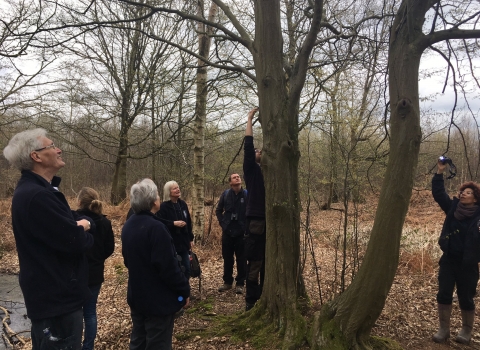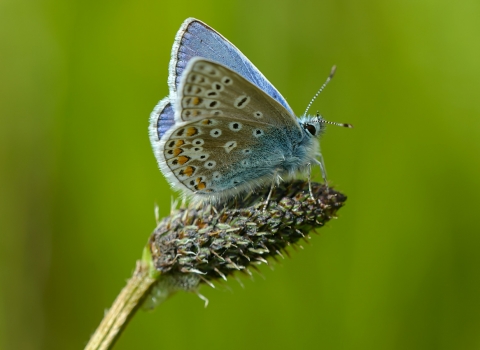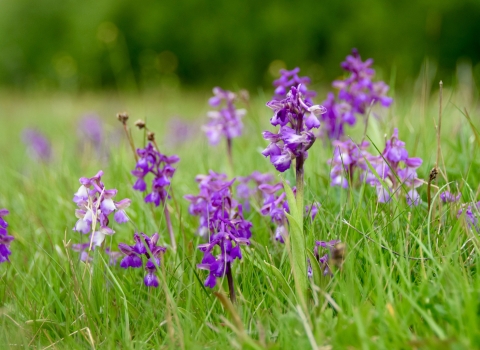We have an extensive portfolio of services, designed to meet customers’ requirements in the most efficient way. Our services include ecology surveys, protected species surveys, habitat creation and management, as well as the design and delivery of training by our own in-house experts. If you require advice and support regarding your project, but are unsure which service you need, contact us for a no obligation discussion and we will do our very best to support the progression of your project at pace.
Preliminary Ecological Appraisal (Phase 1)
Our ‘Preliminary Ecological Appraisal’ (PEA) is a baseline survey required for Planning Applications before any work takes place. This is the first-step in the planning process and can save clients considerable time and costs.
Also known as an ‘Extended Phase 1’ survey, our PEA involves a detailed look at wildlife within the site during a walkover, focussing on protected species such as birds, bats and reptiles. Invasive weeds such as Japanese Knotweed and flora and fauna of special wildlife value are also recorded. Where a site contains a building, an assessment will be carried out by one of our experienced ecologists, searching for signs of roosting bats and nesting barn owls.
Ecological Impact Assessments
An Environmental Impact assessment (EIA) may be required by the Local Planning Authority for certain projects. This requires the developer to compile an Environmental Statement (ES) describing the likely impacts on the environment and proposed mitigation measures to protect wildlife.
Essex Ecology work in collaboration with the client and stakeholders to anticipate the important ecological issues and to agree suitable mitigation from the outset, thereby reducing potential costs and risks by avoiding delays. As part of an EIA, we draw up an Ecological Impact Assessment (EcIA) which is often required by bodies such as county/district councils, Highways Agency and Environment Agency before granting planning permission.
Invasive Weed Assessments
Invasive weeds such as Japanese Knotweed are becoming an increasing issue in the UK, particularly in a development context.
Essex Ecology ecologists are experienced in surveying for ‘alien invaders’ such as Giant Hogweed and Japanese Knotweed, and can flag these up at an early stage, allowing treatment before they become further established. Japanese Knotweed is important to detect and eradicate, as this is listed on Schedule 9 of the Wildlife and Countryside Act and considered ‘Controlled waste’ under the Environmental Protection Act. This means any cut vegetation and soil containing rhizomes must either be burned on site or taken to a licensed landfill site.
Botanical Surveys
Where have all the flowers gone? UK wildlife habitats have declined dramatically, our flower-rich meadows being a prime example, primarily due to increasing pressures from intensive farming and land use changes.
Essex Ecology has in-depth expertise in botany, which is supplemented by our collaboration with Essex Wildlife Trust. Our knowledge has been developed through our learning, during the completion of Phase 1 habitat surveys of wildlife sites since 1993. We carry out a range of botanical assessments including: National Vegetation Classification (NVC) – a way of classifying habitat types in Britain, Hedgerow surveys – identifying older hedgerows of special wildlife value protected by Hedgerow Regulations 1997 and Phase 1 Habitat Surveys – a nationally recognised survey technique for recording semi-natural vegetation and habitats.
Bats
Eastern England supports 12 bat species out of the 17 native to Britain, ranging from large Noctules to diminutive pipistrelles, weighing less than a £1 coin whilst devouring 3000 midges per night!
All bat species receive full legal protection, safeguarding both bats and their roosts, even when not present. Essex Ecology include: desk studies, bat roost assessments of buildings, tree surveys, dusk and dawn bat activity surveys (May – September), Natural England licence applications and design/creation of mitigation habitat e.g. artificial bat roosts. We use the latest in bat detecting technology, including ultrasonic bat detectors and thermal imaging cameras to detect/rule out the presence of bats.
Great Crested Newts
Great Crested Newts (GCN), historically known as ‘warty newts’, are Britain’s largest newt species. The males carry a distinctive crest, which they wave to attract females during the spring breeding season.
GCN have declined in the UK mainly to the loss and lack of management of ponds. For this reason, they and their habitat, both land and water, are afforded legal protection. Essex Ecology provide a range of services to detect and protect GCN or rule them out from the outset of a project. Our services include: desk studies, field surveys including pond assessments, presence/absence surveys involving torchlight searches, trapping and eDNA analysis, licence applications and associated mitigation including safely moving newts to newly created habitats.
Reptiles
We have four reptile species in Eastern England – Grass Snake, Adder, Common Lizard and Slow Worm. With the exception of Adder, mainly found in coastal grassland and heathland, these reptiles are widespread throughout the region.
All reptiles are legally protected which means that reasonable efforts must be made to safeguard them in habitats including rough grassland, brownfield sites and sea walls. Essex Ecology are experienced in addressing reptiles within the planning process and our services include: desk studies, habitat assessments, presence/absence surveys and follow-up mitigation including habitat creation and translocation. The survey technique uses artificial refuges to attract basking reptiles, during their activity season (March – October).
Badgers
Badgers are part of the weasel (mustelid) family and live in underground setts in family groups of up to around 14 individuals. Despite past and present persecution, Badgers are widespread in southern England with ‘hotspots’ of activity e.g. south Essex.
Badgers and their setts are legally protected and Local Planning Authorities will require appropriate surveys for planning applications. Essex Ecology has a proven track record in successfully resolving issues Badgers may present to developers, landowners and home owners whilst safeguarding this charismatic species. Our services range from field surveys, mapping setts and territories, impact assessments and preparing/executing mitigation proposals which may include supervised licensed closure of a sett and creation of a new sett for displaced Badgers.
Barn Owls and other Schedule 1 birds
Barn Owls are an iconic bird species often, but not exclusively, found in barns. They swallow their prey whole and regurgitate the fur and bones as pellets, which can be used to confirm presence and identify their prey of choice (often voles).
Barn Owls are fully protected under Schedule 1 of the Wildlife and Countryside Act. Essex Ecology work in collaboration with licensed staff at Essex Wildlife Trust to ensure Barn Owls are safeguarded during and after barn conversions and other projects, thereby satisfying Local Planning Authority conditions. Where necessary a licence from Natural England may be obtained. EECOS surveys also include consideration of other Schedule 1 birds such as Kingfisher, Peregrine and Bearded Tit.
Breeding and Wintering Birds
The UK supports a huge diversity of bird life from the tiny Gold Crest to rotund Mute Swans, from melodious breeding Nightingale to wading birds of estuaries and salt marshes, and from fleeting migrant visitors on summer or winter passage to year-round residents.
All British birds' nests and their eggs are protected from damage and destruction under the Wildlife and Countryside Act. Species of wintering wildfowl and waders are also afforded protection. Experienced Essex Ecology ornithologists carry out a host of surveys including nesting and wintering bird surveys, wind farm appraisals, Common Bird Census including territory mapping, farmland bird surveys, impact assessments and mitigation strategies to reduce the impacts and enhance the habitats for birds.
Water Voles
Water Voles or ‘Ratty’ as they are affectionately known in Wind in the Willows, are a native mammal of UK rivers, ponds and ditches. They live in burrows and feed on a wide range of vegetation (over 200 plants!) leaving their distinctive calling cards – latrines and ‘feeding stations’.
Water Voles and their burrows are legally protected, important considering their decline, closely tied to the spread of invasive Mink. Essex Ecology have many years of survey experience in the field searching for signs of Water Vole as well as translocation schemes under licence. A boat-based survey is often the only feasible way of accessing habitat and Essex Ecology have a survey canoe capable of navigating most water courses, which is an invaluable resource.
Otters
Otters are a rare ‘good news’ story, having recovered from a collapse in numbers, in recolonising rivers since 1970s, they are now found in every river catchment in Essex. Otters can use 20 kilometres of river and mark territories by leaving sweet smelling droppings (spraints).
Otters and their holts (shelters) are legally protected and Essex Ecology ecologists have many years of survey experience, assisted by our trusty survey canoe. Our range of services will help protect Otters during your project within suitable water bodies. These include desk studies, site assessments, presence/absence surveys mapping activity, and where necessary, designing and implementing mitigation measures to minimise impact on otters during construction, which can include creation of new holts.
Dormice and other small mammals
The Dormouse is an elusive small and nocturnal mammal of old woodland and hedgerows, their name originating from the French word “dormir” – hinting at their love of sleep, spending half of the year in hibernation.
Dormice are afforded legal protection, with numbers having been decimated in the past century by habitat loss and fragmentation, lack of fresh woodland coppicing and the spread of Grey Squirrels competing for food. Essex Ecology are competent and licensed to carry out Dormouse surveys, our services including desk studies, habitat assessments, presence/absence surveys using special ‘Dormouse tubes’ and putting together mitigation and habitat creation plans as and when this is required.
Invertebrates – terrestrial/aquatic
Invertebrates exhibit a staggering diversity, ranging from bees, beetles, butterflies, dragonflies, moths, flies, spiders to molluscs – representing food for bats, birds and small mammals and including pollinators of many plant species.
Some UK invertebrates enjoy legal protection and planning authorities would expect these to be flagged up in ecological impact assessments. These include Brown-banded Carder Bee, Grizzled Skipper butterfly, Violet Oil Beetle and Desmoulin’s Whorl Snail. Essex Ecology entomologists have considerable experience using a variety of specialist equipment from pooters and microscopes to pitfall and moth traps. Our services include desk studies, site habitat assessments, species identification and generic/specialist surveys for target invertebrate groups using a range of techniques, aquatic invertebrate surveys, planning mitigation schemes and conservation management plans.
White-clawed Crayfish
White-clawed Crayfish are the UK’s largest freshwater crustacean and one of the most threatened, having been lost from most British rivers, displaced by the invading American Signal Crayfish and subsequently threatened by the disease, crayfish plague, which they can carry.
For this reason, White-clawed Crayfish are afforded legal protection. Essex Ecology surveyors are licensed to carry out survey work and have facilitated conservation projects and surveys in collaboration with Essex Wildlife Trust and Environment Agency. We work with clients to ensure this species is protected during any projects that may affect remaining populations in rivers and streams. Our services include desk studies, walkover site assessments, presence/absence surveys using nets, torches, traps and canoes and designing mitigation plans as and when required.
Habitat Creation and Management
British wildlife needs a helping hand – we have lost 60 % since the 1970’s, driven in large part by habitat loss. Owners of gardens and estates, developers and local authorities, have an opportunity and responsibility to create new habitats and improve existing ones. The benefits of improving habitats include attracting and sustaining wildlife in these new enhanced areas.
Essex Ecology personnel have practical experience and knowledge to design and carry out a range of work, both creating new and managing existing wildlife habitats. We are licensed to use machinery such as Brushcutters and Chainsaws and we tap in to the extensive resources of Essex Wildlife Trust. Our habitat creation and management services include the following, although we are happy to tailor our products to meet your needs.
- Wildlife gardens – e.g. flowering borders, log piles and wildlife ponds.
- Specific wildlife features – e.g. design and creation of reptile hibernacula and ‘bug hotels.
- Woodland management – a range of forestry services, including felling and coppicing.
- Estate and ground maintenance.
- Habitat creation / reduction.
- Brushcutting, strimming, chainsawing.
- Tree and hedgerow planting.
- Hedge laying/flailing.
- River channel modification including coir roll installation.

Training
In today’s fast moving world, it is important for everyone to keep up to speed with current environmental legislation, identification, habitat management and the whole spectrum of ecological issues they may encounter.
Essex Ecology offer a range of training courses to help you stay ahead and anticipate/resolve any wildlife issues before they arise. We offer a range of ‘off the shelf’ courses covering any topic outlined in our list of services and are happy to tailor bespoke training courses to your needs. We draw on over 80 years’ worth of combined experience in ecological surveys and would love to share our knowledge to help maximise the wildlife value within any given site.
Here are some examples of the training we can offer:
- Protected species and the planning system – timing and development;
- Invasive species;
- Species identification (flora and fauna);
- Protected species surveys (e.g. bats, Great Crested Newts and reptiles);
- Habitat management – Conservation Management Planning;
- Wildlife enhancement – gardens and new development.

Photo John Bridges
Other
This section outlines other services provided by Essex Ecology not listed above. These cover BREEAM, farm surveys, tree safety assessments, ecological clerk of works and conservation management planning. Please contact us if you are unable to find the specific ecological survey or service you require, and we will try our best to help.
BREEAM and CFSH: Land Use and Ecology sections
BREEAM (BRE Environmental Assessment Method) is the leading and most widely used environmental assessment method for buildings, setting the standard for best practice in sustainable design.
Essex Ecology has extensive experience in carrying out a wide range of BREEAM ecological assessments at sites ranging from individual homes to schools, hotels, hospitals and university accommodation. The aim is to protect remaining ecological features and where possible improving the wildlife value within a new planting scheme, for example by installing a biodiverse green roof, enhanced border planting or creating a new pond. We work alongside the developer, the landscape design team and the BREEAM assessor to ensure that maximum wildlife value and corresponding credits are achieved, which is particularly important if the “good” or “excellent” BREEAM standard is required.
Farm Ecology Surveys for Environmental Stewardship Schemes
Most of the land in the UK is farmed, either grazing land or arable. There are huge opportunities to improve the farming landscape for wildlife, thereby helping diminishing populations, farmland birds being a prime example.
Essex Ecology work with farmers and agents to ensure they make the most of environmental/countryside stewardship schemes. Essex Ecology has completed Farm Environment Plans for a range of successful Higher-Level Stewardship Scheme applications covering various habitats and farming methods and for well-established Land Agents. We have also completed FEPs and HLS applications for Essex Wildlife Trust reserves including Tiptree Heath. Our services will include meetings, farm walkover and assessment, designing realistic environmental features/habitats such as headlands, wild bird seed strips, wildlife meadows, skylark patches and new ponds.
Tree Safety Assessments
Essex Ecology are experienced in carrying out tree safety assessments across a wide number of sites, including for Forest Schools.
Tree Safety Assessments are effectively a risk assessment which will focus on an area of woodland. The aim of the assessment is to identify any potential hazards relating to the condition of the trees, both from a physical perspective and from the viewpoint of identifying any diseases the trees may be carrying.
Following the assessment, we will provide outcomes and recommendations for clients, with advice on any remedial works required to ensure the area is safe to be used.
Ecological Clerk of Works
Site supervision by an ecological clerk of works is essential to ensure that legal constraints, planning consents and licensing conditions are correctly observed in respect of protected species and features and that mitigation plans are delivered correctly during construction.
Essex Ecology provides experienced Clerk of Works that will give the appropriate guidance and direction to contractors to provide our clients peace of mind in the knowledge that they are on the right side of conservation legislation. Our services include: ecological inductions for all staff at the start of a project, Toolbox Talks as and when needed, direct supervision at critical stages of the construction programme, regular compliance monitoring visits and resolution of any ecological issues encountered during the ongoing works.
Conservation Management Plans
There are no true wildernesses remaining in the UK. The best wildlife habitats require careful maintenance and management to retain the diversity in species, and the most reliable way of achieving this is through a detailed Conservation Management Plan.
Essex Ecology has significant experience in drawing up Conservation Management Plans, both on a nature reserve scale for local authorities and Essex Wildlife Trust, but also on a smaller site scale, where this is required through the planning system or BREEAM. Local planning authorities are increasingly requiring ecological/biodiversity management plans as part of the planning application portfolio to demonstrate the applicant's intent to deliver on the mitigation recommended in the initial Phase 1 and Phase 2 Habitat Appraisal reports. Essex Ecology can assist the client to draw up such management plans which can cover up to 10-20 years beyond the completion of construction.

